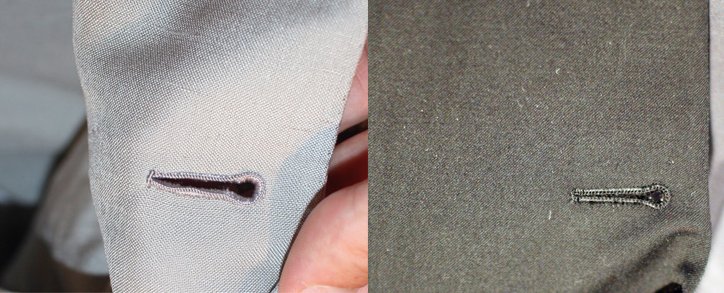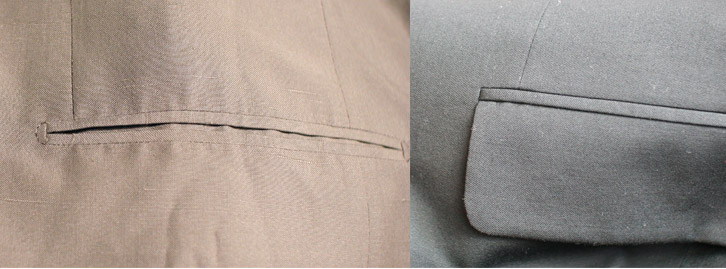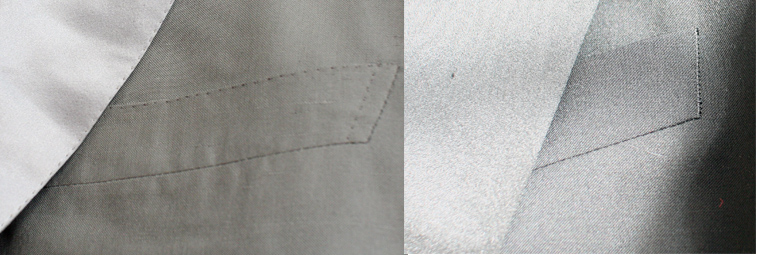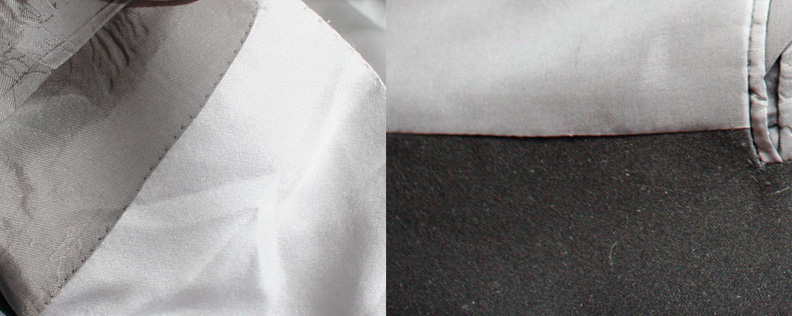So before we go back to the pagoda shoulder, a side-by-side comparison of two dinner jackets, one by Brioni and one by Samuelsohn. This will be done in several parts as I am too lazy to get it all done in one shot. Samuelsohn is on the low price end of the full-canvas makes and Brioni on the higher end (in this case, the Brioni is easily four times the price of the Samuelsohn, if not a little more). So what makes the difference?
Cosmetics- both are one-button, peak lapel DJs. The Sammmy is 100% wool with a center vent, the Brioni is 100% Silk with no vent.
Buttonholes
Brioni- made by hand
Samuelsohn- made by machine
Sleeve finishing
Brioni- hand-made immitation buttonholes
Samuelsohn- machine-made functioning buttonholes, hand-finished sleeve lining
Pockets
Brioni- hand-made, flat construction jetted pocket (nice, soft, flat, discreet) with hand-stitched mezza-luna tack
Samuelsohn- machine-made (ribbed) flap pocket
Breast Welt
I apologize if it's not clear.
Brioni- hand-made and finished pocket welt, pick stitching also done by hand
Samuelsohn- machine-made welt with tiny zig-zag stitching to fell the edge of the pocket, no pick stitching.
Let's pause for a moment.
There is some confusion about pick stitching and what it is or is for. Pick stitching is the tiny little stitches on the edge of some garments- it is placed there to hold the edge crisp and flat, to prevent edges from rolling, but is not structural. As such, a hand stitch is the same structurally as a machine stitch- they both do the same job. Machine pick stitching is not meant to bamboozle anyone- it performs the same function as hand stitching.
HOWEVER
Hand stitching is much smaller and looser and thus more discreet than machine stitching (I'll show both later) and once you're seen the two side-by-side it's easy to tell them apart. Some makers (mostly southern Italians) do their hand stitching with a slightly thicker thread and is just as ornamental as it is functional, but it is still easy to tell them apart by the slight irregularity of the stitches and the tiny prick of the hand stitch.
Hand stitching machines have pretty intense feeders which tend to damage delicate satin, which is why it is not so common to find it on dinner jackets and why there is none on this Samuelsohn garment. It is also much more evident on Satin than on regular cloth and some people find it ostentatious so is often omitted. It was a necessity on the Brioni, for reasons we will get to later.
Boutonniere
Brioni- there is a hand-made buttonhole done with the upside-down buttonhole stitch I was studying in a previous post (and now realize I may have posted the wrong photo) plus a boutonniere loop underneath.
Samuelsohn- no lapel buttonhole
Facing
Brioni- The facing on the Brioni is a luxurious pure silk which is not common to see any more because it is very delicate; damages are common and replacing a facing on a finished jacket is one of the most infuriating jobs. If you are wearing real silk lapels, do not hug anyone wearing jewelry, and keep your dancing partner at a distance for fear of snags. But it is VERY nice.....
Samuelsohn- This has the more common synthetic facing. Note that this type of satin is made specifically (and only) for tuxedo facings and is just as expensive as real silk in most cases. It is popular because it is more resistant to damage, not only during construction but during wear.
In this part we look at some of the details that we can see inside the jacket but without opening the lining up. Clues for the thrifters among us.
Hem finishing
Brioni- The hem has been closed by hand with a tight little stitch. There is also what appears to be a pick stitch running close to the hem- most likely holding wiggan or some sort of hem interfacing in place. It looks like this was done with the Columbia machine (Juki makes one too) which is a type of imitation hand stitch. More on this in a minute.
Samuelsohn- This hem was closed by a felling machine- the two parallel threads are what distinguishes the machine stitch from a hand stitch which may look similar. This type of stitch is usually a good indicator that the coat was not bagged and that the hem itself was felled rather than just tacked like in lesser garments.
Facing and lining seams
Brioni- there is a little pick stitch which was clearly done by hand along this seam. Some manufacturers put a Columbia stitch as decoration along this seam, but on garments such as this, it is possible that the stitch is not primarily decorative but functional- it may be used to fell the lining to the facing by hand. This can also be done with a more discreet stitch, but if the finisher is talented, it can be functional as well as decorative. The lining must be opened up to know for sure.
Samuelsohn-
The lining has been closed by machine and there is no decorative stitching along this edge
Neck Finishing
Brioni- several interesting things. The pick stitching continues around the neck, a further suggestion the lining has been felled by hand. Notice that the lining is lapped over the collar. Also notice the seam in the collar stand- this is a two piece collar, as in my previous post about collar drafting. Silk is very difficult to shape with the iron so they were wise to make this a two piece and avoid possible fit trouble. The shoulder seam of the lining has been felled by hand, which means the lining is held in place along the shoulder pad and won’t shift around.
Samuelsohn- The collar is lapped over the lining, and felled with a machine-made pick stitch; there is also a row of pick stitching just inside the roll line to hold things in place. The shoulder seam has been closed by machine which means it is loose and not tacked to the shoulder pad.








12 comments:
Hello - Please let me know how to email you.
Cheers, mark@winklerbrands.com
Hi
I can be reached at jeffery_d at ymail dot com
Sorry about the other comments that got deleted during the merge. Trying to clean up some of the posts....
Hello I was looking you post on brioni and you mention about a "automated pad stitching machine"
I have a small tailo shop in Costa Rica.
Do you know where in I can order online or get a machine like that? and also do you have if the quality is similar to stitching by hand....regards
my email is fberrocal@loenoracr.com
hi
i would like to know how much a BRIONI would be worth.
i know how much a samuelsohn (i used to work there)
nice review takes me back to the days !
Bonjour Alexandre
I'm not sure how much a dinner jacket might cost but the last time I looked at regular production it was in the 5,000 to 6,000 range.
In the last picture - Neck Finishing, where is the lining-shoulder seam located? I'm trying to determine if they're attached to the shoulder pads or not. Thx
@Jack- the lining shoulder seam is located at the same position as the shoulder seam on the cloth- when it is finished by machine, it is loose, but when done by hand, it is basted onto the pad before finishing.
Great review - can't help but wonder if Brioni is a better company to work for than Samuelsohn?
I wish Samuelsohn would just go the extra mile in adding pick stitching around the lapels and also a Boutonniere on the lapel. I would gladly pay the extra $200 to see these features add to an already outstanding suit (do you know how many big name companies use fusing?) Samuelsohn,Canali, Brioni, Cornelliani, maybe Kiton are defintely fitting a nitch for discerning buyers. But I sure would like to see Samuelsohn go the extra yard in adding pick stitching.
P.S. you can always have a good tailor close the center vent... I do that with all my Canali suits.
When I had my last two suits custom made by Samuelsohn, I had a lapel boutonniere added to accommodate my medals. All in all, I can't justify a garment by Brioni at 4 times plus the cost over a Samuelsohn. The pick stitching on the lapel was great, so was the surgeon's sleeves, i.e. button-holes on the sleeves. And, they definitely were out to please. I did not like what they sent me the first time so they made it right, and sent me a re-done garment in the exact specifications. $2800-$3200 for a top of the line Samuelsohn, with the right loro piana or zegna fabric and I guarantee you will be happy or they will fix it for you. $9000-$12000 for a suit is for people who would rather waste money on clothes than put it in the stock market.
Post a Comment